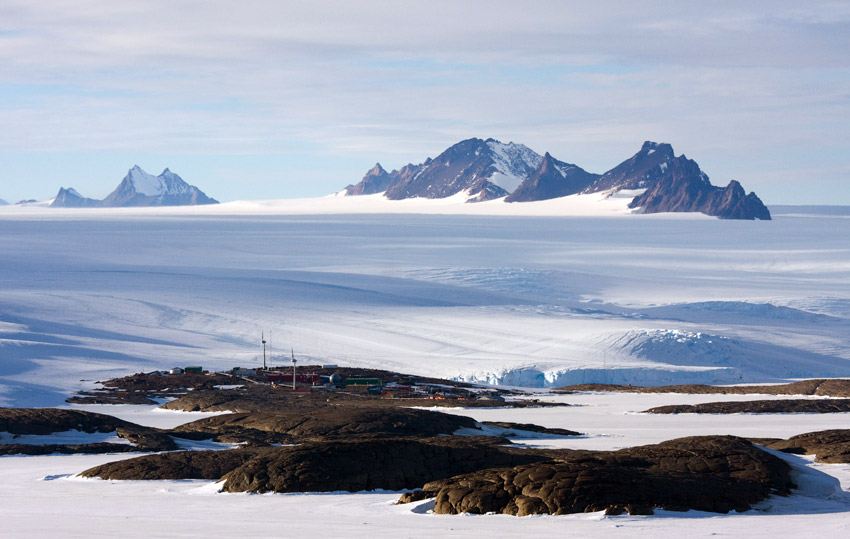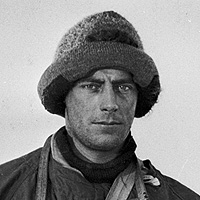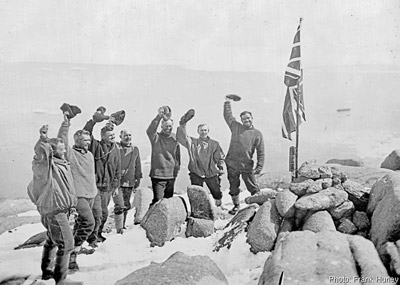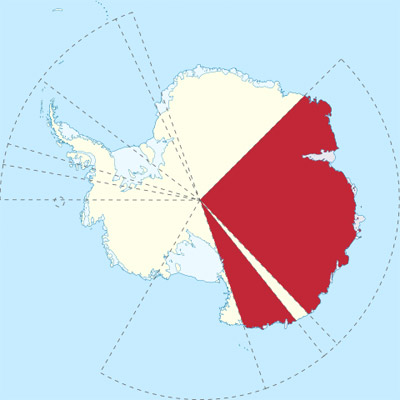 Australians
in Antarctica
Australians
in Antarctica
History and Activity
Australia has a long and involved history in Antarctica. From the sealing and then whaling days of the 19th century to the Heroic Age of 1898-1922. Involvement continued in the International Geophysical Year 1957-58 and into the present day with a number of modern scientific bases currently at the forefront of modern research in Antarctica.
Current activity
Australian Antarctic Division (AAD) is the government organization that has responsibility for Australia's Antarctic programme.
|
Research Station and position |
Summer staff | Winter staff | Occupied | Use |
| Casey, Vincennes
Bay, Wilkes Land 66°17.00'S, 110°31.18'E |
70 | 20 | 1969 - present | Year round |
| Davis, Princess
Elizabeth Land 68°34.63'S, 077°58.35'E |
70 | 22 | 1957 - present | Year round |
| Macquarie Island,
sub Antarctic 54°30' S, 158°57' E |
40 | 16 | 1958 - present | Year round |
| Mawson, Mac
Robertson Land 67°36.28'S, 062°52.25'E |
60 | 20 | 1954 - present | Year round |
The icebreaker RSV Aurora Australis is used to supply the stations and conduct research in the Southern Ocean, this is due to be retired and replaced with a new ship, the RSV Nuyina in 2020 . Since 2004 flights have left from Hobart, Tasmania directly to Antarctica to transfer personnel and further supplies. Smaller aircraft and helicopters are used within Antarctica for moving between stations and reaching temporary field camps.
AAD headquarters is in Kingston, Tasmania - website:
http://www.antarctica.gov.au/

Mawson Station (Australia) from Welch
Island. 5 am, December 26, 2008
Image used cutesy Bignoter at en.wikipedia
Creative Commons Attribution 3.0 Unported licence
Heroic Age Expeditions 1898-1922

![]() 1907-09
- Shackleton - Nimrod -
British Antarctic Expedition
1907-09
- Shackleton - Nimrod -
British Antarctic Expedition
Douglas Mawson - Physicist - One of the aims of the expedition was to try and reach the South Pole, though this part did not involve Mawson and wasn't achieved. Mawson was one of a three man team to reach the Southern Geomagnetic Pole for the first time after a 1260 mile man-hauled journey. He was also a member of the first team to ever climb Mount Erebus, the world's southernmost active volcano on Ross Island. On return to Australia, Mawson began planning his own Australian Antarctic Expedition turning down a place offered by captain Scott on his Terra Nova Expedition to take place during 1910-13.

![]() 1910-13 - Scott - Terra Nova
- British
Antarctic Expedition
1910-13 - Scott - Terra Nova
- British
Antarctic Expedition
Frank Debenham - Geologist - Born in New South Wales in 1883. Debenham didn't take part in the South Pole journey due to a knee injury sustained while playing football in the snow, he took part in two western journeys with others exploring and mapping the western mountains of Victoria Land.
In 1920 using the remainder of public donations received following the deaths of Scott and others of the Polar Party, Debenham along with Raymond Priestly founded the Scott Polar Research Institute, part of Cambridge University.

![]() 1911-14 - Mawson - Aurora -
Australasian
Antarctic Expedition
1911-14 - Mawson - Aurora -
Australasian
Antarctic Expedition
An expedition supported by the Australian Association for the Advancement of Science, there were ambitious aims to explore 2000 miles of coastline directly south of Australia and to set up two overwintering bases to allow inland exploration to take place using dog teams. A base was also to be established on sub-Antarctic Macquarie Island. The members of the expedition were almost all Australians or New Zealanders.
Unknown to Mawson at the time, they had set the main base up in one of the windiest places on earth, no-one had set foot on Antarctica along this 2000 mile stretch of coastline before they landed, so they had little idea of the conditions prior to arrival. Anything that was not tied down was blown away. When the men left the safety of the huts it was vital to be wearing crampons fitted onto the bottom of their boots so they didn't get blown over too. Through March and April the wind often gusted over 100 miles per hour and occasionally to over 200 miles per hour.
All of the sled parties that left the base suffered difficulties, though none matched the ordeal of Mawson, Metz and Ninnis that only Mawson was to survive and only just at that.
The Australasian Antarctic Expedition is today regarded as one of the greatest polar scientific expeditions of all time because of the detailed observations in magnetism, geology, biology and meteorology that were made. Mawson's own tale of survival is one of the most gripping of Antarctic adventures.

![]() 1914
- 17 - Shackleton - Endurance -
British Trans-Antarctica Expedition
1914
- 17 - Shackleton - Endurance -
British Trans-Antarctica Expedition
Frank Hurley - Photographer - A veteran of Mawson's expedition, Hurley was the only member of the expedition that Shackleton didn't meet or interview before the expedition set off, he was accepted on the the strength of his work with Mawson on the 1911-13 Australasian Antarctic Expedition. It is largely due to Hurley's pictures that we are able to get such a good impression of the events and that the Endurance story is still very alive and capturing people's imaginations even today.
Exploration Scientific Bases and Research after 1922
![]() November 1928
November 1928
Hubert Wilkins makes the first flight in Antarctica. A five man team with two single engined Lockheed Vega aircraft set off for Deception Island on board a whaling factory ship. The intention was to try and fly from the Peninsula region across the continent to the Ross Sea. While this wasn't possible, a number of flights were made in summers of 1928, 1929 and 1930 that showed the possibilities of aircraft use in Antarctica including aerial photography and mapping and also the limitations.

![]()
![]()
![]() 1929-31
- British, Australian and New Zealand Antarctic Research Expedition
- BANZARE
1929-31
- British, Australian and New Zealand Antarctic Research Expedition
- BANZARE
The French had in 1924 laid claim to Terre Adelie or Adelie Land in the sector directly south of Australia. What became popularly known as BANZARE was an attempt by (now Sir) Douglas Mawson and others in Australia to encourage the government to file a similar claim. After a meeting in London, a joint expedition was proposed, partially privately funded, it used the RRS Discovery and had a small floatplane. The expedition didn't overwinter in Antarctica but consisted of two summer cruises in 1929-30 and 1930-31, surveying and mapping by ship and from the air. Land was claimed as British territory. It led to the establishment of the Australian Antarctic Territory.
![]()
![]()
![]()
![]() 1955-1958
- Commonwealth Trans-Antarctic Expedition
1955-1958
- Commonwealth Trans-Antarctic Expedition
Funded by the governments of Britain, Australia, New Zealand
and South Africa, this was an attempt to do what Shackleton
had set out to do in 1914, to cross the Antarctic Continent
from sea to sea via the South Pole. Led by the British Vivian
Fuchs from the Weddell Sea and New Zealander Edmund Hilary from
the Ross Sea. Hilary arrived at the Pole on the 4th of January
1958, Fuchs on the 19th, they both reached the Ross Sea again
on the 2nd of March.
videos of the expedition
Territorial Claims
 There
is a historical claim of the Australian Antarctic Territory
dating back to 1933 when it was claimed by the UK and placed
under the Commonwealth of Australia.
There
is a historical claim of the Australian Antarctic Territory
dating back to 1933 when it was claimed by the UK and placed
under the Commonwealth of Australia.The region is that area of Antarctica between 45°E and 160°E except for Adelie Land between 136°E and 142°E (claimed by France) and stretching as far north as 60°S, this is 42% of the Antarctic Continent.
Australia is one of seven nations that made a claim to land in Antarctica before the Antarctic Treaty of 1961, these being Argentina, Chile, the United Kingdom, France, Australia, New Zealand and Norway. The UK, France, Australia, New Zealand and Norway all recognize each other's claims, these are non-overlapping.
The Antarctic Treaty, Article IV - 2 states: "No acts or activities taking place while the present Treaty is in force shall constitute a basis for asserting, supporting or denying a claim to territorial sovereignty in Antarctica. No new claim, or enlargement of an existing claim, to territorial sovereignty shall be asserted while the present Treaty is in force"
So the Antarctic Treaty does not suspend or defer existing claims, though it does state that:
- No activities occurring after 1961 can be the basis of a territorial claim.
- No new claim can be made.
- No claim can be enlarged.
Practically though territorial claims have been effectively suspended since 1961.
Image of claim map used courtesy TUBS, license via Wikimedia Commons


